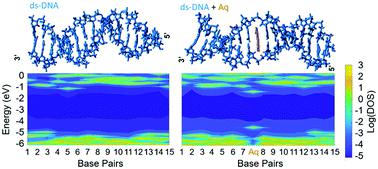当前位置:
X-MOL 学术
›
Nanoscale Horiz.
›
论文详情
Our official English website, www.x-mol.net, welcomes your feedback! (Note: you will need to create a separate account there.)
Role of intercalation in the electrical properties of nucleic acids for use in molecular electronics
Nanoscale Horizons ( IF 9.7 ) Pub Date : 2021-06-08 , DOI: 10.1039/d1nh00211b Hashem Mohammad 1 , Busra Demir 2 , Caglanaz Akin 2 , Binquan Luan 3 , Joshua Hihath 4 , Ersin Emre Oren 2 , M P Anantram 1
Nanoscale Horizons ( IF 9.7 ) Pub Date : 2021-06-08 , DOI: 10.1039/d1nh00211b Hashem Mohammad 1 , Busra Demir 2 , Caglanaz Akin 2 , Binquan Luan 3 , Joshua Hihath 4 , Ersin Emre Oren 2 , M P Anantram 1
Affiliation

|
Intercalating ds-DNA/RNA with small molecules can play an essential role in controlling the electron transmission probability for molecular electronics applications such as biosensors, single-molecule transistors, and data storage. However, its applications are limited due to a lack of understanding of the nature of intercalation and electron transport mechanisms. We addressed this long-standing problem by studying the effect of intercalation on both the molecular structure and charge transport along the nucleic acids using molecular dynamics simulations and first-principles calculations coupled with the Green's function method, respectively. The study on anthraquinone and anthraquinone–neomycin conjugate intercalation into short nucleic acids reveals some universal features: (1) the intercalation affects the transmission by two mechanisms: (a) inducing energy levels within the bandgap and (b) shifting the location of the Fermi energy with respect to the molecular orbitals of the nucleic acid, (2) the effect of intercalation was found to be dependent on the redox state of the intercalator: while oxidized anthraquinone decreases, reduced anthraquinone increases the conductance, and (3) the sequence of the intercalated nucleic acid further affects the transmission: lowering the AT-region length was found to enhance the electronic coupling of the intercalator with GC bases, hence yielding an increase of more than four times in conductance. We anticipate our study to inspire designing intercalator–nucleic acid complexes for potential use in molecular electronics via creating a multi-level gating effect.
中文翻译:

嵌入在用于分子电子学的核酸电特性中的作用
用小分子插入 ds-DNA/RNA 可以在控制分子电子应用(如生物传感器、单分子晶体管和数据存储)的电子传输概率方面发挥重要作用。然而,由于对嵌入和电子传输机制的性质缺乏了解,其应用受到限制。我们通过分别使用分子动力学模拟和第一性原理计算以及格林函数方法研究嵌入对分子结构和沿核酸的电荷传输的影响来解决这个长期存在的问题。蒽醌和蒽醌-新霉素缀合物嵌入短核酸的研究揭示了一些普遍特征:(1)嵌入通过两种机制影响传播:(a) 在带隙内诱导能级和 (b) 相对于核酸的分子轨道改变费米能量的位置,(2) 发现嵌入的影响取决于嵌入剂的氧化还原状态:虽然氧化蒽醌减少,还原蒽醌增加电导,并且 (3) 嵌入核酸的序列进一步影响传输:发现降低 AT 区长度可增强嵌入剂与 GC 碱基的电子耦合,从而产生电导增加四倍以上。我们预计我们的研究将激发设计嵌入剂-核酸复合物以用于分子电子学的潜在用途 氧化蒽醌减少,还原蒽醌增加电导,(3)嵌入核酸的序列进一步影响传输:发现降低 AT 区长度可增强嵌入剂与 GC 碱基的电子耦合,从而产生电导增加四倍以上。我们预计我们的研究将激发设计嵌入剂-核酸复合物以用于分子电子学的潜在用途 氧化蒽醌减少,还原蒽醌增加电导,(3)嵌入核酸的序列进一步影响传输:发现降低 AT 区长度可增强嵌入剂与 GC 碱基的电子耦合,从而产生电导增加四倍以上。我们预计我们的研究将激发设计嵌入剂-核酸复合物以用于分子电子学的潜在用途通过创建多级门控效果。
更新日期:2021-07-01
中文翻译:

嵌入在用于分子电子学的核酸电特性中的作用
用小分子插入 ds-DNA/RNA 可以在控制分子电子应用(如生物传感器、单分子晶体管和数据存储)的电子传输概率方面发挥重要作用。然而,由于对嵌入和电子传输机制的性质缺乏了解,其应用受到限制。我们通过分别使用分子动力学模拟和第一性原理计算以及格林函数方法研究嵌入对分子结构和沿核酸的电荷传输的影响来解决这个长期存在的问题。蒽醌和蒽醌-新霉素缀合物嵌入短核酸的研究揭示了一些普遍特征:(1)嵌入通过两种机制影响传播:(a) 在带隙内诱导能级和 (b) 相对于核酸的分子轨道改变费米能量的位置,(2) 发现嵌入的影响取决于嵌入剂的氧化还原状态:虽然氧化蒽醌减少,还原蒽醌增加电导,并且 (3) 嵌入核酸的序列进一步影响传输:发现降低 AT 区长度可增强嵌入剂与 GC 碱基的电子耦合,从而产生电导增加四倍以上。我们预计我们的研究将激发设计嵌入剂-核酸复合物以用于分子电子学的潜在用途 氧化蒽醌减少,还原蒽醌增加电导,(3)嵌入核酸的序列进一步影响传输:发现降低 AT 区长度可增强嵌入剂与 GC 碱基的电子耦合,从而产生电导增加四倍以上。我们预计我们的研究将激发设计嵌入剂-核酸复合物以用于分子电子学的潜在用途 氧化蒽醌减少,还原蒽醌增加电导,(3)嵌入核酸的序列进一步影响传输:发现降低 AT 区长度可增强嵌入剂与 GC 碱基的电子耦合,从而产生电导增加四倍以上。我们预计我们的研究将激发设计嵌入剂-核酸复合物以用于分子电子学的潜在用途通过创建多级门控效果。


























 京公网安备 11010802027423号
京公网安备 11010802027423号